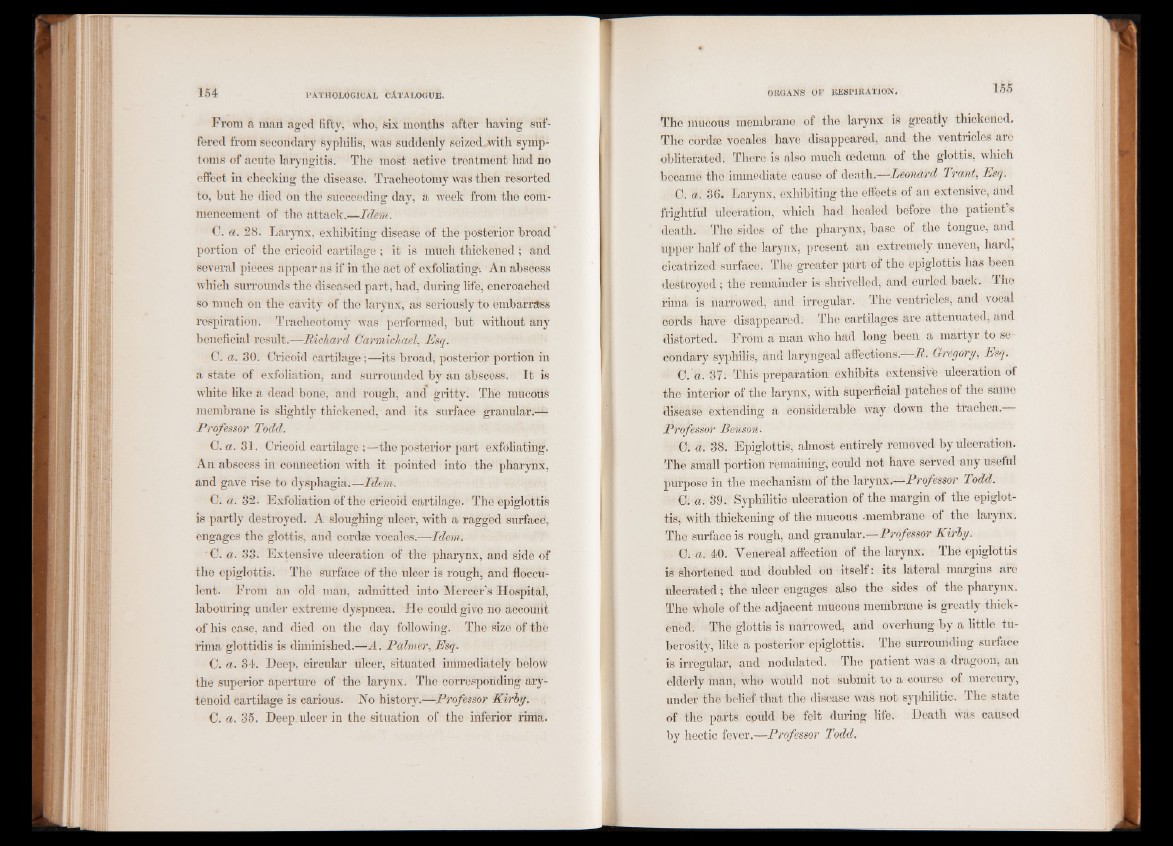
From a man aged fifty, who, six months after having suffered
from secondary syphilis, was suddenly seized, with symptoms
of acute laryngitis. The most active treatment had no
effect in checking the disease. Tracheotomy was then resorted
to, but he died on the succeeding day, a week from the commencement
of the attack.—Idem.
0. a. 28. Larynx, exhibiting disease of the posterior broad'
portion of the cricoid cartilage ; it is much thickened ; and
several pieces appear as if in the act of exfoliating*. An abscess
which surrounds the diseased part, had, during life, encroached
so much on the cavity of the larynx, as seriously to embarrass
respiration. Tracheotomy was performed, but without any
beneficial result.—Bichard Carmichael, Esq.
0. a. 30. Cricoid cartilage;—its broad, posterior portion in
a state of exfoliation, and surrounded by an abscess. It is
white like a dead bone, and rough, and gritty. The mucous
membrane is slightly thickened, and its surface granular.—
Professor Todd.
C. a. 31. Cricoid cartilage ;—the posterior part exfoliating.
An abscess in connection with it pointed into the pharynx,
and gave rise to dysphagia.—Idem.
C. a. 32. Exfoliation of the cricoid cartilage. The epiglottis
is partly destroyed. A sloughing ulcer, with a ragged surface,
engages the glottis, and cordee vocales.—Idem.
C. a. 33. Extensive ulceration of the pharynx, and side of
the epiglottis. The surface of the ulcer is rough, and floccU-
lent. From an old man, admitted into Mercer’s Hospital,
labouring under extreme dyspnoea. He could give no accouiit
of his case, and died on the day following. The size of the
rima glottidis is diminished.—A. Palmer, Esq.
C. a. 34. Deep, circular ulcer, situated immediately below
the superior aperture of the larynx. The corresponding arytenoid
cartilage is carious. No history.—Professor Kirby.
C. a. 35. Deep ulcer in the situation of the inferior rima.
The mucous membrane of the larynx is greatly thickened.
The cordse vocales have disappeared, and the ventricles are
obliterated. There is also much oedema of the glottis, which
became the immediate cause of death.—Leonard Trant, Esq.
C. a. 36. Larynx, exhibiting the effects of an extensive, and
frightful ulceration, which had healed before the patient s
death. The sides of the pharynx, base of the tongue, and
upper half of the larynx, present an extremely uneven, hard,
cicatrized surface. The greater part of the epiglottis has been
destroyed ; the remainder is shrivelled, and curled back. The
rima is narrowed, and irregular. The ventricles, and vocal
cords have disappeared. The cartilages are attenuated, and
distorted. From a man who had long been a martyr to se condary
syphilis, and laryngeal affections. B. Gregory, Esq.
C.'h. 37. This preparation exhibits extensive ulceration of
the interior of the larynx, with superficial patches of the same
disease extending a considerable way down the trachea.
Professor Benson.
0. a. 38. Epiglottis, almost entirely removed by ulceration.
The small portion remaining, could not have served any useful
purpose in the mechanism of the larynx.—Professor Todd.
C. a. 39. Syphilitic ulceration of the margin of the epiglottis,
with thickening of the mucous -membrane of the larynx.
The surface is rough, and granular.—Professor Kirby.
0. a. 40. Venereal affection of the larynx. The epiglottis
is shortened and doubled oil itself: its lateral margins are
ulcerated; the ulcer engages also the sides of the pharynx.
The whole of the adjacent mucous membrane is greatly thickened.
The glottis is narrowed, and overhung by a little tuberosity,
like a posterior epiglottis. The surrounding surface
is irregular, and nodulated. The patient was a dragoon, an
elderly man, who would not submit to a course of mercury,
under the belief that the disease was not syphilitic. The state
of the parts cpuld be felt during life. Death was caused
by hectic fever.—Professor Todd.